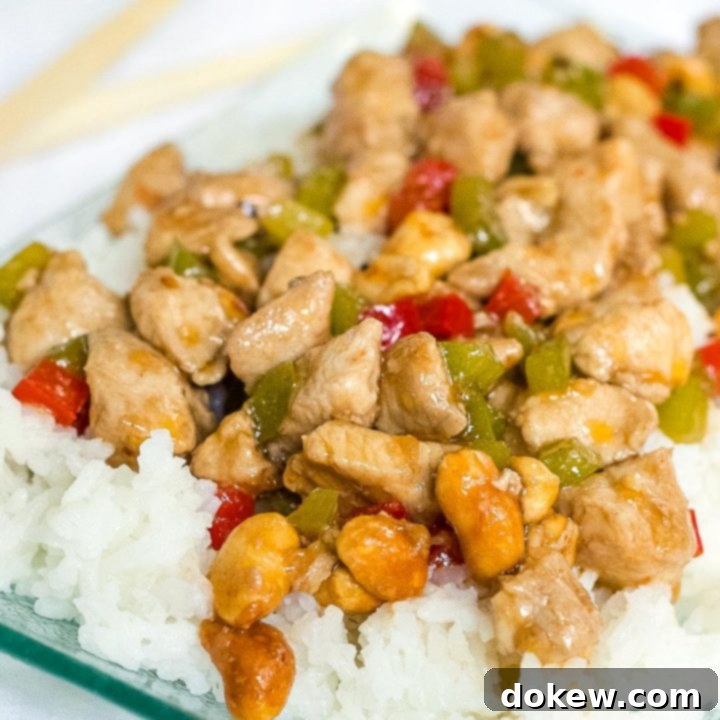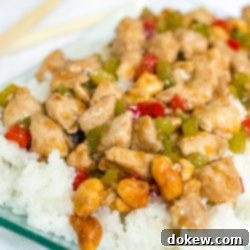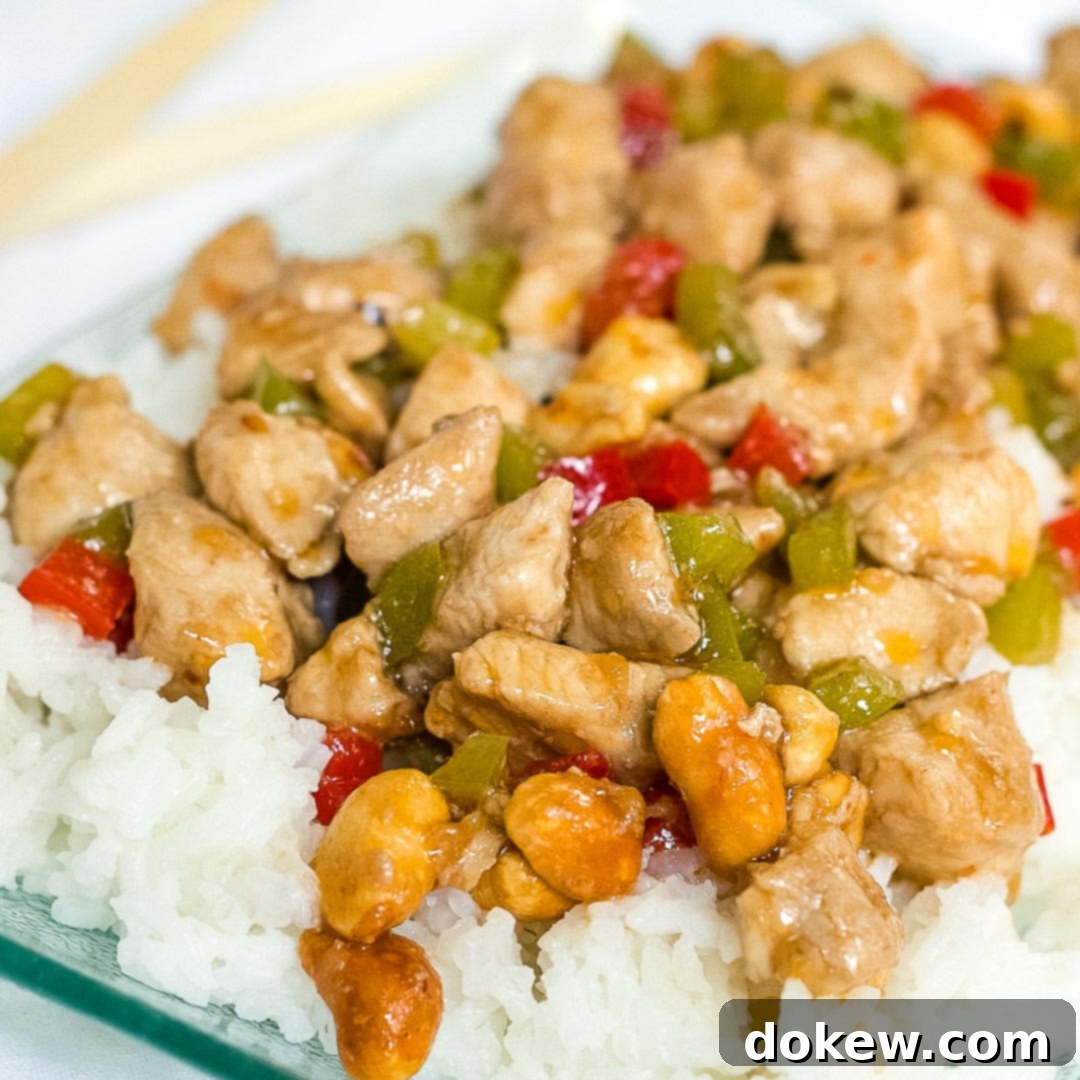The Ultimate Homemade Kung Pao Chicken Recipe: A Spicy, Savory, and Satisfying Stir-Fry Experience
Dive into the vibrant, authentic flavors of Chinese cuisine with this incredible Kung Pao Chicken recipe. Renowned for its perfect balance of spicy, savory, and sweet notes, coupled with the satisfying crunch of peanuts and crisp vegetables, this dish is a beloved takeout classic that’s surprisingly easy to master in your own kitchen. Our recipe highlights a crucial step for achieving restaurant-quality results: an overnight marinade that guarantees exceptionally tender and deeply flavorful chicken. Combined with a simple yet potent chili-infused oil, this homemade rendition promises to elevate your weeknight dinners or impress guests at your next gathering.

Unveiling Kung Pao Chicken: A Culinary History and Flavor Profile
Kung Pao Chicken (Gong Bao Ji Ding – 宫保鸡丁) is a celebrated Sichuanese stir-fry dish, famous for its bold, dynamic, and complex flavor profile. Originating from the Sichuan province in southwestern China, it’s characterized by its signature “mala” (numbing and spicy) taste, traditionally derived from the combination of Sichuan peppercorns and dried red chilies. While many Westernized versions may temper the heat and adapt certain ingredients, the authentic essence of Kung Pao Chicken lies in its harmonious blend of textures and tastes: succulent chicken, crunchy peanuts, and vibrant vegetables, all coated in a rich, multi-layered sauce.
The dish is named after Ding Baozhen (1820–1886), a distinguished official during the late Qing Dynasty who served as the governor of Sichuan province. His official title, “Gong Bao,” translates to “palace guardian.” According to culinary folklore, Ding Baozhen either created this iconic dish himself or was particularly fond of a version served to him. Over generations, it has evolved into a global culinary icon, cherished for its irresistible fusion of textures and its distinctive spicy-sweet-savory profile.
What Makes This Kung Pao Chicken Recipe Special?
Our rendition of Kung Pao Chicken isn’t just another stir-fry; it’s a carefully crafted recipe designed to deliver an exceptional culinary experience. The secrets to its success are rooted in a few key components:
- **The Overnight Marinade:** This step is truly transformative. Allowing the chicken to marinate for an extended period, preferably overnight, in a mixture of soy sauce, rice cooking wine, and cornstarch, ensures that each piece of chicken is incredibly tender, juicy, and infused with flavor. This “velveting” technique protects the chicken from drying out during high-heat cooking and creates a wonderfully smooth texture. It’s the difference between good and great Kung Pao Chicken.
- **Homemade Chili-Flavored Oil:** Instead of relying on store-bought chili oil, this recipe guides you through creating a fresh, aromatic chili oil right in your wok. Sautéing dried red chilies in hot oil releases their essential oils and infuses the entire dish with an authentic, fragrant spice that is both exhilarating and deeply nuanced. This method also gives you complete control over the heat level, allowing you to tailor it to your preference.
- **A Perfectly Balanced Sauce:** The stir-fry sauce is a masterclass in flavor harmony, featuring a delightful interplay of sweet, sour, salty, and umami. It effortlessly coats the chicken and vegetables, creating a glossy finish and a depth of flavor that is genuinely addictive and keeps you coming back for more.
- **Fresh, Crisp Vegetables:** Diced green and red bell peppers are not just for color; they provide a delightful sweetness and a necessary crisp-tender crunch that beautifully contrasts with the tender chicken and the rich sauce.
- **The Essential Peanuts:** The addition of roasted peanuts is non-negotiable for authentic Kung Pao Chicken. They contribute a crucial textural counterpoint – a satisfying crunch – and a rich, nutty flavor that completes the dish’s complex profile.
The Power of the Overnight Marinade: Maximizing Flavor and Tenderness
While many stir-fry recipes suggest a brief 30-minute marinade, embracing an overnight marination period truly elevates this Kung Pao Chicken to an extraordinary level. Here’s why this seemingly simple step is worth the extra planning:
- **Deep Flavor Penetration:** The extended marination time allows the chicken to thoroughly absorb the savory notes from the soy sauce and the aromatic qualities of the rice cooking wine. This ensures that the flavor isn’t just on the surface but penetrates deep into every fiber of the chicken, resulting in a more profound and satisfying taste.
- **Unparalleled Tenderness (Velveting):** Cornstarch plays a critical role in the marinade, a technique known as “velveting” in Chinese cooking. It forms a thin, protective coating around the chicken pieces. When cooked at high heat, this coating locks in moisture, preventing the chicken from becoming tough or dry. The rice cooking wine also aids in tenderizing the meat, further enhancing its succulence.
- **Consistent Texture and Cooking:** Properly marinated chicken tends to cook more evenly. The pre-treatment helps standardize the chicken’s texture, reducing the likelihood of some pieces being overcooked and dry while others remain undercooked.
While starting the marinade the night before requires a bit of foresight, it involves minimal active effort. Moreover, it significantly streamlines your dinner preparation on the cooking day, as your primary protein is already perfectly seasoned and primed for the wok. The payoff in terms of succulent texture and rich flavor is undeniably worth the wait.
Recipe

Kung Pao Chicken
★
★
★
★
Add to Shopping ListGo to Shopping List
Ingredients
Chicken Marinade
- 2 tablespoons soy sauce
- 1 tablespoon rice cooking wine (Shaoxing wine preferred)
- 1 teaspoon cornstarch
Kung Pao & Stir-Fry Ingredients
- 1 lb boneless, skinless chicken breast or thighs, cut into bite-sized pieces
- 2-4 small dried red chilies, or ¼ to ½ tsp crushed red pepper flakes, adjusted to taste
- 1 tablespoon fresh ginger, minced
- 2 garlic cloves, minced
- ½ cup roasted peanuts, unsalted preferred
- 1 green bell pepper, diced into 1-inch pieces
- 1 red bell pepper, diced into 1-inch pieces
- 6 tablespoons vegetable oil, divided
Kung Pao Sauce
- 2 tablespoons soy sauce, low-sodium optional
- 2 tablespoons sesame oil, toasted for best flavor
- 1 teaspoon rice cooking wine (Shaoxing wine preferred)
- 1 tablespoon rice vinegar, or Chinkiang black vinegar for more depth
- 1 tablespoon granulated sugar
- 1 tablespoon cornstarch
Instructions
-
**Prepare the Chicken Marinade:** In a medium-sized bowl, combine the bite-sized chicken pieces with 2 tablespoons of soy sauce, 1 tablespoon of rice cooking wine, and 1 teaspoon of cornstarch. Toss thoroughly to ensure all chicken pieces are evenly coated. Cover the bowl and refrigerate for a minimum of 12 hours, or ideally overnight, allowing ample time for the flavors to infuse and the chicken to tenderize fully.
-
**Whisk the Kung Pao Sauce:** In a separate small bowl, prepare the stir-fry sauce. Combine 1 tablespoon of rice vinegar (or Chinkiang black vinegar for a deeper flavor), 2 tablespoons of soy sauce, 2 tablespoons of sesame oil, 1 teaspoon of rice cooking wine, 1 tablespoon of granulated sugar, and 1 tablespoon of cornstarch. Whisk vigorously until the sugar and cornstarch are completely dissolved and the sauce mixture is smooth. Set aside.
-
**Cook the Chicken:** Heat 4 tablespoons of vegetable oil in a large wok or a heavy-bottomed skillet over high heat until the oil is shimmering and almost smoking. Add the marinated chicken in a single layer. If you have a large amount of chicken, cook it in batches to avoid overcrowding the wok, which can cause the chicken to steam rather than sear and brown. Stir-fry for 3-5 minutes, or until the chicken is cooked through and lightly golden on all sides. Remove the cooked chicken from the wok and transfer it to a clean plate; set aside.
-
**Create the Chili-Infused Oil:** If there are any burnt residues in the wok, quickly rinse it out and ensure it’s thoroughly dry. Add the remaining 2 tablespoons of vegetable oil to the clean wok and heat over medium-high heat. Add the dried red chilies (or crushed red pepper flakes, if using). Stir-fry for approximately 15-30 seconds, watching carefully until the chilies turn a dark red to almost black color. Be vigilant not to burn them, as burnt chilies will impart a bitter taste to the dish. This step is essential for creating the signature chili-flavored oil that forms the fragrant base of Kung Pao Chicken.
-
**Sauté Aromatics and Vegetables:** Immediately add the minced fresh ginger and minced garlic to the wok, stirring constantly for about 30 seconds until they become fragrant. Next, add the diced green and red bell peppers. Continue to stir-fry for 2-3 minutes, allowing the peppers to soften slightly while still retaining a pleasant crisp bite.
-
**Combine and Thicken with Sauce:** Return the previously cooked chicken to the wok with the sautéed vegetables and aromatics. Give the prepared Kung Pao sauce another quick whisk, as the cornstarch tends to settle at the bottom. Pour the sauce evenly over all the ingredients in the wok. Stir continuously for 1-2 minutes as the sauce heats through and thickens, beautifully coating the chicken and vegetables.
-
**Finish and Serve:** Remove the wok from the heat. Stir in the roasted peanuts. For an extra touch of freshness and color, garnish the finished dish with a sprinkle of fresh chopped scallions (optional). Serve your homemade Kung Pao Chicken immediately over steaming hot white or brown rice for a complete and satisfying meal.
Notes
**Adjusting Spice Level:** The quantity of dried red chilies can be easily adjusted to match your personal heat preference. For a milder dish, use fewer chilies or omit them entirely. For those who love extra heat and the authentic “mala” sensation, consider adding a pinch of ground Sichuan peppercorns during the chili oil preparation step.
**Soy Sauce Options:** If you are monitoring your sodium intake, feel free to substitute regular soy sauce with a low-sodium variety without compromising on flavor.
**Peanut Preparation:** Ensure your peanuts are roasted. If you are starting with raw peanuts, dry roast them in a pan or oven until fragrant and slightly browned before adding them to the dish to enhance their flavor and crunch.
Nutrition per serving
Share
Pin
Tips for Mastering Your Homemade Kung Pao Chicken
Achieving restaurant-quality Kung Pao Chicken at home is entirely possible with these expert tips:
- **Embrace High Heat:** Stir-frying demands intense heat to properly sear the chicken and maintain the crisp-tender texture of the vegetables. Always ensure your wok or pan is smoking hot before you add any ingredients.
- **Avoid Overcrowding:** When cooking the chicken, do it in batches if necessary. Overcrowding the wok will lower the temperature, causing the chicken to steam instead of sear, leading to a less desirable texture.
- **Practice “Mise en Place”:** This French culinary term, meaning “everything in its place,” is paramount for stir-fries. Have all your ingredients – chicken, vegetables, aromatics, and sauce – chopped, measured, and ready next to your cooking station before you begin, as the actual cooking process is incredibly fast.
- **Fresh Aromatics are Key:** Do not compromise on fresh ginger and garlic. They form the foundational aromatic base that significantly enhances the overall flavor of the dish.
- **Taste and Adjust the Sauce:** Before adding the whisked sauce to the wok, give it a quick taste. This is your opportunity to fine-tune the balance of flavors. You can add more sugar for sweetness, a dash more vinegar for tanginess, or a splash of soy sauce for increased saltiness, according to your preference.
- **Choose the Right Cooking Oil:** While any vegetable oil will work, using a high smoke point oil such as peanut oil, canola oil, or grapeseed oil is ideal for stir-frying as it can withstand the high temperatures required without breaking down.
Creative Variations and Customizations
Kung Pao Chicken is a wonderfully versatile dish that lends itself well to various modifications, allowing you to tailor it to dietary needs or personal preferences:
- **Protein Alternatives:**
- **Tofu Kung Pao:** For a delicious vegetarian option, use extra-firm tofu. Press it to remove excess water, cut into cubes, marinate, and pan-fry until golden brown and crispy before incorporating it into the stir-fry.
- **Shrimp or Beef:** Replace the chicken with large shrimp (cook quickly to avoid toughness) or thinly sliced beef (such as flank or sirloin). Adjust marinating times; shrimp requires a much shorter marinade.
- **Additional Vegetables:**
- **Mushrooms:** Sliced cremini or shiitake mushrooms add an earthy, umami depth to the dish.
- **Carrots:** Thinly sliced carrots can be added alongside the bell peppers for extra color, sweetness, and a different texture.
- **Zucchini or Broccoli:** Cut into bite-sized florets, these vegetables are excellent additions. For broccoli, blanch it briefly in boiling water before adding to the stir-fry for optimal tenderness.
- **Water Chestnuts or Bamboo Shoots:** Incorporate these for an authentic Asian touch and a delightful crunch.
- **Nut Substitutions:** If peanuts are not suitable due to allergies or preference, roasted cashews make an excellent substitute, providing a similar crunch and rich, nutty flavor. Ensure they are unsalted if possible.
- **Boosting the Spice Level:** For those who desire a truly fiery kick and the signature numbing sensation of Sichuan cuisine, add a pinch of ground Sichuan peppercorns along with the dried chilies during the oil infusion step. A dash of chili garlic sauce or sriracha can also be stirred into the finished dish for an extra layer of heat.
Perfect Serving Suggestions
To fully appreciate the vibrant flavors of Kung Pao Chicken, it is traditionally and best served:
- Over steaming hot, fluffy white rice, such as Jasmine rice, which beautifully absorbs the sauce.
- With brown rice for a healthier, slightly nuttier alternative that complements the dish.
- Alongside stir-fried noodles or classic lo mein for a heartier meal.
- Accompanied by a simple side of steamed or lightly stir-fried green vegetables, such as bok choy, gai lan, or green beans, to complete the meal.
The bold and complex flavors of Kung Pao Chicken make it a fulfilling meal on its own, but a thoughtfully chosen side dish can enhance the dining experience.
The Takeaway: Your New Favorite Homemade Chinese Stir-Fry
This homemade Kung Pao Chicken recipe is more than just a meal; it’s a journey into the rich and diverse culinary landscape of China. The meticulous overnight marinade transforms ordinary chicken into something extraordinarily tender and deeply flavorful, while the freshly made chili oil infuses every bite with tantalizing warmth and a complex aroma. With its perfectly balanced blend of sweet, sour, salty, and spicy notes, and the irresistible textural contrast from the crunchy peanuts and crisp bell peppers, this dish is guaranteed to become a family favorite. Skip the takeout menu tonight and delight in the satisfaction of creating an authentic, flavorful Chinese stir-fry in your own kitchen. Enjoy the process, savor the enticing aromas, and revel in the truly delicious results!
